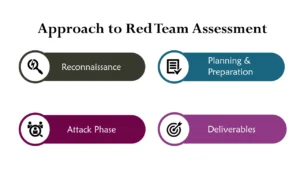Index
- Introduction
- What is Red Teaming?
- The Role of Red Team in Cybersecurity
- Red Teaming Methodology
- Key Components of Red Teaming Security
- Red Team assessments
- The Red Teaming Process
- Red Teaming in Different Industries
- Common Red Teaming Tactics
- Challenges and Considerations
- Conclusion
- FAQs
With cyber threats becoming more sophisticated day by day, organisations can no longer rely solely on reactive security measures. There is a growing need to take a proactive approach to testing and improve security defences before attacks occur. This is where the concept of Red Teaming comes in – the practice of simulating real-world attacks to assess the robustness of an organisation’s security systems continuously.
In this blog, we will explore what exactly Red Teaming is, understand its emergence as a crucial cybersecurity practice, and discuss the pivotal role it plays in strengthening overall security posture.
What is Red Teaming?
Red Teaming refers to the practice of employing cybersecurity professionals to simulate real-world attacks against an organisation’s IT systems and networks. The core objective is to continuously test and improve security defences by taking an adversarial approach.
The primary goals of Red Teaming include:
- Identifying unknown security vulnerabilities that existing tools and audits fail to detect
- Assessing the ability of security staff to detect and respond to breaches
- Evaluating the resilience of security controls and procedures when faced with sophisticated attacks
Red Teaming differs from traditional security testing in its holistic focus on end-to-end breach simulation from an advanced attacker’s point of view. While vulnerability assessments rely on automated scans, Red Teams employ a wide range of techniques used by real-world threats to penetrate defences.
The Role of Red Team in Cybersecurity
Red Teaming plays an invaluable role in strengthening cyber defences by providing a legal and ethical way for organisations to test their security posture against simulated real-world attacks continuously.
Proactive Threat Simulation
Red Teams act as ‘professional hackers’ using the latest TTPs (tactics, techniques, and procedures) of advanced threat actors to emulate malicious behaviour.
Identifying Vulnerabilities
Through end-to-end breach simulations spanning initial access, lateral movement, and data exfiltration, Red Teams can uncover security gaps that traditional audits often miss.
Stress Testing Security Posture
Red Teaming enables continuous stress testing of security posture by simulating multi-vector attacks under the element of surprise.
Red Teaming Methodology
Red Teams follow a systematic methodology to provide maximum value for improving security defences. The key stages include:
Planning and Scoping
In the planning phase, the scope, rules of engagement, attack vectors, and duration of the simulation are defined in collaboration with the client organisation.
Threat Intelligence Utilisation
Red Teams thoroughly analyse current threat intelligence on the latest attacker tools, techniques, and procedures before simulations. This ensures realistic adversary emulation based on real-world threats.
Execution and Analysis
Red Teams execute a planned series of simulated attacks leveraging varied techniques across IT infrastructure and employees.
Reporting and Recommendations
After concluding the simulation, Red Teams provided a detailed report highlighting security gaps identified during the engagement.
Key Components of Red Teaming Security
Red Teaming seeks to provide a holistic assessment of security vulnerabilities by evaluating multiple facets through simulated breaches. Some key components include:
Social Engineering
One of the most important focus areas for Red Teams is assessing human vulnerabilities. Social engineering techniques like phishing, vishing (voice phishing), and impersonation are used to manipulate employees and gain access.
Technical Exploitation
Red Teaming heavily focuses on technical penetration testing to find weaknesses in networks, applications, endpoints, and cloud environments.
Physical Security Assessments
Red Teams also test physical security controls by attempting unauthorised entry into facilities, theft of assets, and planting devices.
Red Team assessments
Red teaming is a proactive security practice that involves simulated cyber attacks against an organisation to test its defences continuously. The goal of red teaming is to evaluate security from an adversary’s point of view.
Red team exercises provide organisations with valuable insight into the robustness of their detection, prevention, and response capabilities. By mimicking an attacker’s techniques, red teams help identify gaps that could be exploited in a real breach.
The Red Teaming Process
Red Teaming simulations involve a systematic process from start to finish to provide maximum value. The key phases include:
Goal-mapping
At the start, business goals for the engagement are defined, such as evaluating specific security controls, testing incident response, etc. The scope and rules of engagement are also finalised.
Target Reconnaissance
Red Teams gather intelligence on the target organisation’s infrastructure and systems, leveraging OSINT, social engineering, and more.
Exploit Vulnerabilities
Actual exploit execution begins by capitalising on identified weaknesses. Initial access is gained using phishing, exploits, social engineering, or physical entry.
Probing and Escalation
Access and privileges are escalated through lateral movement techniques like credential theft, network pivoting, etc. Critical assets are probed to simulate adversaries’ activities post-breach.
Reporting and Analysis
Detailed reporting is conducted, highlighting successes, failures, detection rate, and response effectiveness. Recommendations are provided for improving defences.
Red Teaming in Different Industries
While the fundamental principles of Red Teaming remain the same across sectors, the specific focus areas vary depending on industry-specific threats and high-value assets.
- Financial Services: For banks and financial institutions, Red Teams prioritise testing security around sensitive customer data, accounts, transactions, and core financial systems.
- Healthcare: In healthcare, the key focus is evaluating security defences around electronic health records, medical devices, research data, and patient information privacy.
- Government: For government agencies, Red Teams simulate attacks against classified systems, public-facing portals, identity management systems, and election infrastructure security.
- Retail: In retail, Red Teaming looks for vulnerabilities in point-of-sale systems, inventory management, loyalty programs, and e-commerce platforms that can lead to theft of customer payment data and intellectual property.
Common Red Teaming Tactics
Red Teams leverage a wide range of techniques to simulate real-world adversaries based on the latest attack trends. Some common tactics include:
- Social Engineering: Social engineering, like phishing, and impersonation, is extensively used to manipulate employees to gain initial access and steal credentials.
- Phishing: Phishing is one of the most prevalent cyber attack vectors. Red Teams send fraudulent emails with malicious attachments or links aimed at stealing credentials or spreading malware.
- Privilege Escalation: Once inside a system, red teams use privilege escalation techniques to gain elevated permissions, allowing greater lateral movement and data access.
Challenges and Considerations
While Red Teaming delivers immense value, there are some common challenges and ethical considerations to address:
- Ethical Concerns: Simulating malicious activities raises some ethical concerns around consent, transparency, and potential business disruption. Proper planning, rules of engagement, and executive buy-in are crucial to conduct ethical Red Teaming.
- Integration with Blue Teams: While Red Teams play the attacker role, collaboration with internal ‘Blue Teams responsible for defence is vital. Clear communication ensures Blue Teams can effectively monitor and respond to simulations, enhancing overall learning.
Conclusion
Adopting a proactive approach to security through Red Teaming exercises provides immense value in strengthening defences. By continuously emulating the tactics and techniques of real-world adversaries, Red Teams enable identifying previously unknown vulnerabilities before they can be exploited. The preventative and forward-thinking nature of Red Teaming fills a critical gap that other security approaches fail to address.
The time to strengthen your cybersecurity defences is now. Take control of your security posture with 63SATS – India’s foremost provider of cutting-edge cybersecurity solutions powered by a top-tier team of experts. Let us be your cyber force against emerging threats.
Our real-world attack simulations, 24/7 monitoring, managed services, and highly customised offerings will provide the actionable threat intelligence and resilience your organisation needs to embrace new opportunities in today’s digital landscape confidently.
Partner with the pioneers taking cybersecurity to the next level. Rise above the noise with 63SATS and secure your path to a glorious future!








